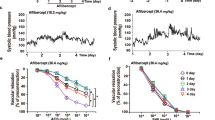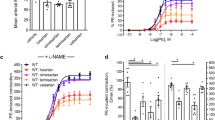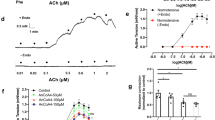Abstract
NG-Nitro-L-arginine-methyl ester (L-NAME)–induced hypertension is a well established model of experimental hypertension. Although regression experiments are effective at approximating a clinical setting the reversal of already established L-NAME hypertension has not been intensively researched. We investigated whether spontaneous regression of L-NAME hypertension after discontinuing the drug administration was associated with recovery of endothelial dysfunction. Special attention was devoted to NO signaling and endothelium-derived constricting factor (EDCF) formation in various parts of the vascular tree. Male adult Wistar rats were divided into 4 groups: an L-NAME (5 weeks), a spontaneous recovery (5 weeks L-NAME + 3 weeks of recovery) and two age-matched control groups (a 5- and 8-week control group). The NO-mediated and EDCF-mediated components of acetylcholine-induced responses were evaluated in preconstricted small mesenteric and femoral arteries. The activity, mRNA and protein expression of NO synthase together with the mRNA expression of cyclooxygenase were determined in the aorta. L-NAME administration caused hypertension, impaired NO signaling (as indicated by the reduced NO component of acetylcholine-induced relaxation and decreased NO synthase activity) in all arteries investigated and reduced the inner diameter of the femoral artery. Moreover, we observed enhanced cyclooxygenase-dependent EDCF formation in the femoral arteries and enhanced cyclooxygenase-2 expression in the aortas of L-NAME–treated rats. During spontaneous recovery a functional restoration of NO signaling took place in all parts of the vascular tree. However, the increases in systolic blood pressure, EDCF formation, and cyclooxygenase expression and the reduction in femoral artery diameter were not completely restored. We conclude that impaired NO signaling was improved after the cessation of L-NAME administration. However, persisting arterial structural alterations and enhanced EDCF formation may decelerate blood pressure reduction even after the restoration of NO synthase activity.
Similar content being viewed by others
Article PDF
References
Konishi M, Su C : Role of endothelium in dilator responses of spontaneously hypertensive rat arteries. Hypertension 1983; 5: 881–886.
Lockette W, Otsuka Y, Carretero O : The loss of endothelium-dependent vascular relaxation in hypertension. Hypertension 1986; 8 ( Suppl II): II-61–II-66.
Lüscher TF, Raij L, Vanhoutte PM : Endothelium-dependent vascular responses in normotensive and hypertensive Dahl rats. Hypertension 1987; 9: 157–163.
Vanhoutte PM, Boulanger CM : Endothelium-dependent responses in hypertension. Hypertens Res 1995; 18: 87–98.
Mori Y, Ohyanagi M, Koida S, Ueda A, Ishiko K, Iwasaki T : Effects of endothelium-derived hyperpolarizing factor and nitric oxide on endothelial function in femoral resistance arteries of spontaneously hypertensive rats. Hypertens Res 2006; 29: 187–195.
Morton JJ, Beattie EC, Speirs A, Gulliver F : Persistent hypertension following inhibition of nitric oxide formation in the young Wistar rat: role of renin and vascular hypertrophy. J Hypertens 1993; 11: 1083–1088.
Haudenschild CC, Prescott MF, Chobanian AV : Effects of hypertension and its reversal on aortic intima lesions of the rat. Hypertension 1980; 2: 33–44.
Bernatova I, Pechanova O, Babal P, Kysela S, Stvrtina S, Andriantsitohaina R : Wine polyphenols improve cardiovascular remodeling and vascular function in NO-deficient hypertension. Am J Physiol Heart Circ Physiol 2002; 282: H942–H948.
Kristek F : Different structure of coronary wall in two types of hypertension: NO deficiency and SHR, in Moncada S, Gustafsson LE, Wiklund NP, Higgs EA (eds): The Biology of Nitric Oxide (Pt 7). London, Portland Press Ltd, 1997, p 69.
Paulis L, Zicha J, Kunes J, et al: Regression of L-NAME-induced hypertension: the role of NO-pathway and endothelium-derived constricting factor. J Hypertens 2006; 24 ( Suppl 4): S7 ( Abstract).
Lüscher TF, Vanhoutte PM : Endothelium-dependent contractions to acetylcholine in the aorta of the spontaneously hypertensive rat. Hypertension 1986; 8: 344–348.
Mulvany MJ, Halpern W : Contractile properties of small arterial resistance vessels in spontaneously hypertensive and normotensive rats. Circ Res 1977; 41: 19–26.
Koga T, Takata Y, Kobayashi K, Takishita S, Yamashita Y, Fujishima M : Age and hypertension promote endothelium-dependent contractions to acetylcholine in the aorta of the rat. Hypertension 1989; 14: 542–548.
Bredt DS, Snyder SH : Isolation of nitric oxide synthetase, a calmodulin-requiring enzyme. Proc Natl Acad Sci U S A 1990; 87: 682–685.
Bernatova I, Pechanova O, Kristek F : Mechanism of structural remodeling of the rat aorta during long-term NG-nitro-L-arginine methyl ester treatment. Jpn J Pharmacol 1999; 81: 99–106.
Lowry OH, Rosebrough NJ, Farr AL, Randall RJ : Protein measurement with the Folin phenol reagent. J Biol Chem 1951; 193: 265–275.
Ribeiro MO, Antunes E, de-Nucci G, Lovisolo SM, Zatz R : Chronic inhibition of nitric oxide synthesis. A new model of arterial hypertension. Hypertension 1992; 20: 298–303.
Pechanova O, Bernatova I, Pelouch V, Simko F : Protein remodeling of the heart in NO deficient hypertension: the effect of captopril. J Mol Cell Cardiol 1997; 29: 3365–3374.
Simko F, Matuskova J, Luptak I, et al: Effect of simvastatin on remodeling of the left ventricle and aorta in L-NAME–induced hypertension. Life Sci 2004; 74: 1211–1224.
Rossi MA, Colombini-Netto M : Chronic inhibition of NO synthesis per se promotes structural intimal remodeling of the rat aorta. J Hypertens 2001; 19: 1567–1579.
Nagao T, Illiano S, Vanhoutte PM : Heterogeneous distribution of endothelium-dependent relaxations resistant to NG-nitro-L-arginine in rats. Am J Physiol 1992; 263: H1090–H1094.
Yanagisawa M, Kurihara H, Kimura S, et al: A novel potent vasoconstrictor peptide produced by vascular endothelial cells. Nature 1988; 332: 411–415.
Kifor I, Dzau VJ : Endothelial renin-angiotensin pathway: evidence for intracellular synthesis and secretion of angiotensin. Circ Res 1987; 60: 422–428.
Kato T, Iwama Y, Okumura K, Hashimoto H, Ito T, Satake T : Prostaglandin H2 may be the endothelium-derived contracting factor released by acetylcholine in the aorta of the rat. Hypertension 1990; 15: 475–481.
Vanhoutte PM, Katusic ZS : Endothelium-derived contracting factor: endothelin and/or superoxide anion? Trends Pharmacol Sci 1988; 9: 229–230.
Jameson M, Dai FX, Lüscher T, Skopec J, Diederich A, Diederich D : Endothelium-derived contracting factors in resistance arteries of young spontaneously hypertensive rats before development of overt hypertension. Hypertension 1993; 21: 280–288.
Katusic ZS, Vanhoutte PM : Superoxide anion is an endothelium-derived contracting factor. Am J Physiol 1989; 257: H33–H37.
Pearson PJ, Lin PJ, Schaff HV : Production of endothelium-derived contracting factor is enhanced after coronary reperfusion. Ann Thorac Surg 1991; 51: 788–793.
Beckman JS, Beckman TW, Chen J, Marshall PA : Apparent hydroxyl radical production by peroxynitrite: implications for endothelial injury from nitric oxide and superoxide. Proc Natl Acad Sci U S A 1990; 87: 1620–1624.
Kanner J, Harel S, Granit R : Nitric oxide, an inhibitor of lipid oxidation by lipoxygenase, cyclooxygenase and hemoglobin. Lipids 1992; 27: 46–49.
Luscher TF, Aarhus LL, Vanhoutte PM : Indomethacin improves the impaired endothelium-dependent relaxations in small mesenteric arteries of the spontaneously hypertensive rat. Am J Hypertens 1990; 3: 55–58.
Dahl LK : Effects of chronic excess salt feeding. Induction of self-sustaining hypertension in rats. J Exp Med 1961; 114: 231–236.
Herrera-Acosta J, Gabbai F, Franco M, et al: Glomerular hemodynamics in persistent renovascular hypertension in the rat. Hypertension 1983; 5: V110–V114.
Bernatova I, Pechanova O, Pelouch V, Simko F : Regression of chronic L-NAME–treatment–induced left ventricular hypertrophy: effect of captopril. J Mol Cell Cardiol 2000; 32: 177–185.
Lüscher TF, Diederich D, Weber E, Vanhoutte PM, Bühler FR : Endothelium-dependent responses in carotid and renal arteries of normotensive and hypertensive rats. Hypertension 1988; 11: 573–578.
Katusic ZS, Shepherd JT, Vanhoutte PM : Endothelium-dependent contractions to stretch in canine basilar arteries. Am J Physiol 1987; 252: H671–H673.
Hansson L, Zanchetti A, Carruthers SG, et al: Effects of intensive blood-pressure lowering and low-dose aspirin in patients with hypertension: principal results of the Hypertension Optimal Treatment (HOT) randomized trial. HOT Study Group. Lancet 1998; 351: 1755–1762.
Author information
Authors and Affiliations
Corresponding author
Rights and permissions
About this article
Cite this article
Paulis, L., Zicha, J., Kunes, J. et al. Regression of L-NAME–Induced Hypertension: The Role of Nitric Oxide and Endothelium-Derived Constricting Factor. Hypertens Res 31, 793–803 (2008). https://doi.org/10.1291/hypres.31.793
Received:
Accepted:
Issue date:
DOI: https://doi.org/10.1291/hypres.31.793
Keywords
This article is cited by
-
Nitric oxide storage levels modulate vasodilation and the hypotensive effect induced by photobiomodulation using an aluminum gallium arsenide (AlGaAs) diode laser (660 nm)
Lasers in Medical Science (2022)
-
Electrical stimulation of the carotid sinus lowers arterial pressure and improves heart rate variability in l-NAME hypertensive conscious rats
Hypertension Research (2020)
-
Molecular metabolic fingerprinting approach to investigate the effects of borneol on metabolic alterations in the liver of nitric oxide deficient hypertensive rats
Molecular and Cellular Biochemistry (2012)
-
Effect of L-NAME-induced hypertension on melatonin receptors and melatonin levels in the pineal gland and the peripheral organs of rats
Hypertension Research (2009)



